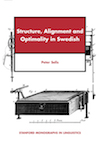This volume explores the grammatical structure of sentences in Swedish, presenting an account of the order of the words and phrases within the clause. This analysis is presented from the perspective of Optimality Theory—a theory of constraint interpretation which allows constraints to conflict by allowing the satisfaction of certain constraints or requirements to lead to a grammatical structure even if less important constraints are violated—within the theoretical framework of Lexical-Functional Grammar. This framework provides syntactic analysis in terms of functions within the clause such as subject, object, and also topic and focus, as well as part-of-speech analysis in terms of noun phrase, verb phrase, and so on, and the hierarchical structure of those constituents. Sells argues for the superiority of a base-generated account of the phenomenon known as Object Shift, and shows how an account based on the notion of Alignment within a ranked constraint system provides a natural account of it. The nature of the Verb-Second sentence pattern and syntactic differences between Swedish and the other Mainland Scandinavian languages are also considered.
Read an excerpt from this book.
Peter Sells is Professor of Linguistics at the School of Oriental and African Studies, University of London.
- Acknowledgements
- 1 Introduction
- 1.1 Outline
- 1.2 Object Shift
- 1.3 LFG
- 2 Clause Structure in Swedish
- 2.1 Designated Positions in Clausal Syntax
- 2.1.1 Positions within the Clause
- 2.1.2 The Functional Categories of IP and CP
- 2.1.3 Embedded V2
- 2.2 The IP/CP Analysis
- 2.2.1 Evidence for the IP/CP Split
- 2.2.2 Deviation from V2
- 2.2.3 Embedded V2
- 2.3 V2 in LFG
- 2.3.1 The Nature of V2-1 and V2-2
- 2.3.2 The Formal Analysis
- 3 Object Shift
- 3.1 Introduction
- 3.2 Pronominal Object Shift in Swedish
- 3.2.1 The Basic Facts
- 3.2.2 Additional Facts Relating to ‘Holmberg's Generalization’
- 3.2.3 Why Swedish Structures Must Be Base-Generated
- 3.3 Clausal-Internal Structure
- 3.3.1 The Position of Shifted Pronouns
- 3.3.2 The Position of Negation and Other Medial Adverbs
- 3.3.3 Adverbial Intermingling
- 3.3.4 Long Object Shift
- 3.3.5 The Structure of Particles
- 3.4 Ordering Constraints I: C-structure Constraints
- 3.4.1 Previous OT Work
- 3.4.2 Alignment in Swedish
- 3.5 Ordering Constraints II: F-structure Constraints
- 3.5.1 The Domains of Alignment
- 3.5.2 F-Alignment vs. F-Precedence
- 3.5.3 F-predicate
- 3.5.4 Particles Revisited
- 3.5.5 Complex Predicates
- 3.5.6 Summary
- 3.6 Distribution Clitics
- 3.7 Negative Quantifiers
- 3.7.1 Negative Quantifiers
- 3.7.2 NegQPs are External to VP
- 3.7.3 Problem Examples
- 3.7.4 Structure-Function Associations
- 3.7.5 Summary
- 4 The OT-LFG Framework
- 4.1 The OT Architecture
- 4.2 An Example From Verb Positioning
- 4.2.1 English
- 4.2.2 French
- 4.2.3 Swedish
- 4.2.4 An OT Analysis
- 4.3 The Properties of GEN
- 4.3.1 General Properties
- 4.3.2 Heads
- 4.3.3 Complements
- 4.3.4 Specifiers
- 4.3.5 Modifiers
- 4.3.6 X0 Structures
- 4.3.7 Summary
- 4.4 The Clausal Skeleton
- 4.4.1 Skeleton Constraints
- 4.4.2 V-Final Languages
- 4.4.3 The Interpretation of Spine-R
- 4.4.4 Summary
- 4.5 Summary
- 5 The Analysis of Object Shift
- 5.1 Constraints for Structure
- 5.1.1 Markedness Constraints and V2
- 5.1.2 Swedish Clausal
- 5.2 Alignment Constraints
- 5.2.1 The Basic Alignment Constraints
- 5.2.2 Adverb Alignment
- 5.2.3 Constraint Evaluation
- 5.2.4 Complex Adverbial Structures
- 5.2.5 Object Shift in Danish and Norwegian
- 5.3 Conclusion
- 5.3.1 What Allows Onject Shift?
- 5.3.2 Homberg's Generalization in OT Syntax
- 6 Theoretical Comparison
- 6.1 The Syntactic Derivation of Object Shift
- 6.1.1 The Equidistance Account
- 6.1.2 Movement to SpecAgrOP
- 6.1.3 V-Raising
- 6.1.4 What Motivates Object Shift?
- 6.1.5 Summary
- 6.2 Previous Analyses
- 6.2.1 Holmberg and Platzack (1995)
- 6.2.2 Platzack (1998)
- 6.2.3 Holmberg (1997b, 1999)
- 6.2.4 Chomsky (2001)
- 6.2.5 Kaiser (1997)
- 6.2.6 Broekhuis
- 6.3 Inference-based Extensions
- 7 Areas for further Investigation
- 7.1 Clausal Skeleton
- 7.2 Functional Alignment Constraints
- 7.3 Shape Preservation: Alignment or Precedence?
- 7.4 Repulsion from VP
- 7.5 Object Shift in Icelandic
- 7.6 Final Remarks
- References
- Name Index
- Subject Index
5/1/2001


